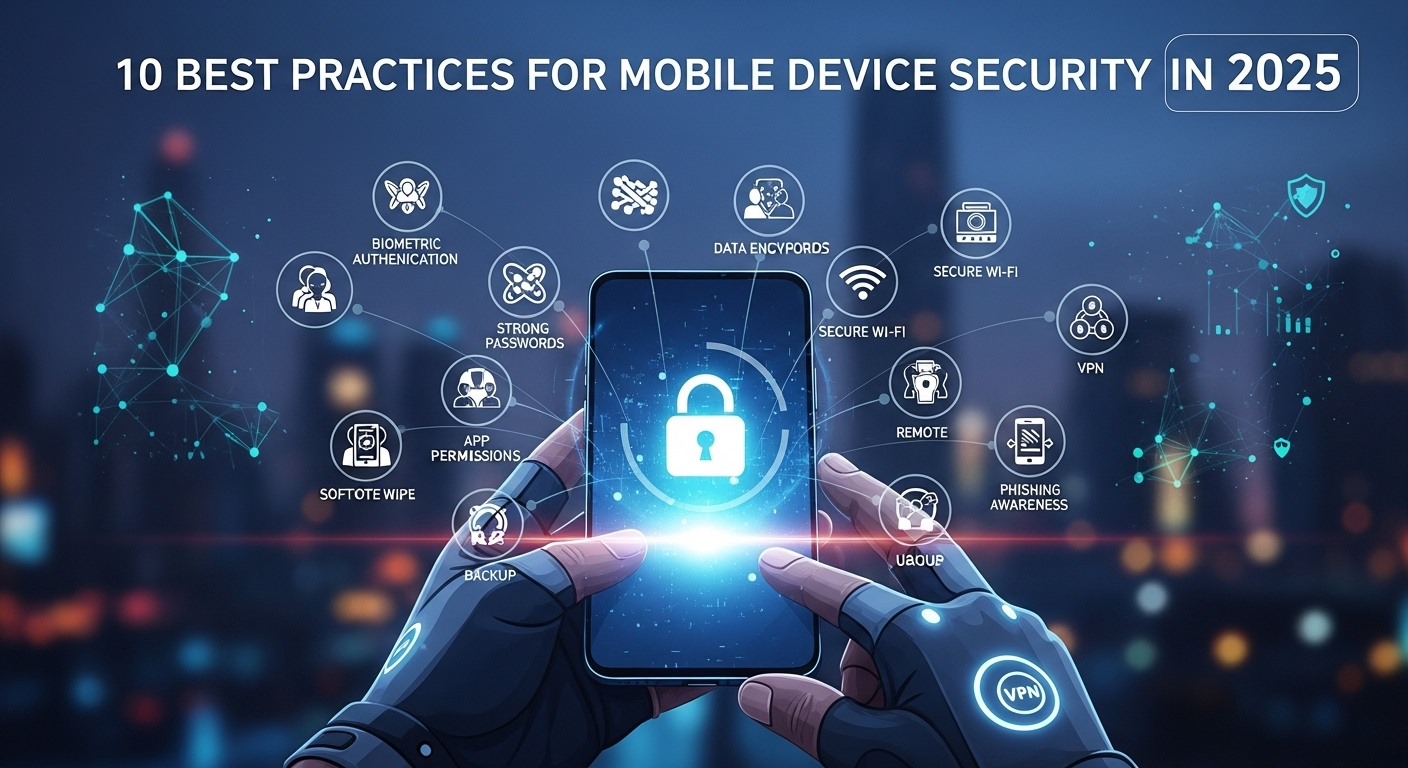Best practices for mobile device security are no longer optional — they are essential. As mobile devices become the primary computing platform for users and enterprises alike, securing them against evolving threats requires layered defenses, up-to-date policies, and ongoing monitoring. H2: Why mobile device security matters in 2025Mobile devices now store sensitive personal and corporate data, access cloud services, and control IoT endpoints. That ubiquity makes them high-value targets for attackers. Compromised mobile devices can lead to identity theft, corporate breaches, ransomware, and supply-chain compromises. For long-term resilience, organizations and individuals must adopt proven security patterns and the latest defensive technologies. The threat landscape has shifted. Attack vectors such as smishing, rogue apps, malicious SDKs, and SIM-swapping remain common, while AI-assisted phishing and automated malware distribution are increasing. Meanwhile, broader changes — widespread 5G, eSIM adoption, and complex app ecosystems — create both opportunities and new security considerations. Adopting the best practices for mobile device security reduces risk and improves incident response readiness. Regulatory and business drivers also influence priorities. Privacy regulations (e.g., GDPR-like frameworks), industry compliance requirements, and customer expectations demand demonstrable safeguards. Organizations that invest in mobile security gain not only risk reduction but also competitive trust advantages. H2: Device hardening and authenticationDevice-level protections are the foundation of mobile security. Start by ensuring devices use the latest OS versions and security patches — unpatched devices are one of the most exploited weaknesses in mobile fleets. Combine system updates with hardware-backed protections like secure enclaves and verified boot to raise the bar for attackers. Strong authentication and biometrics Biometric authentication (fingerprint, face) and multi-factor authentication (MFA) dramatically reduce account takeover risk. Biometrics tied to hardware-backed keystores prevent credential extraction. Use MFA for cloud apps, VPNs, and device unlock. While biometrics improve usability, always offer fallback MFA (PIN + hardware token) for accessibility and redundancy. Biometric systems must be implemented with privacy and anti-spoofing in mind. Configure timeouts and re-authentication windows for high-risk operations (e.g., financial transactions). Where possible, adopt standards-based approaches (FIDO2/WebAuthn) to reduce reliance on passwords and provide stronger cryptographic authentication. Secure boot, encryption, and lock screens Enable full-disk or file-based encryption to protect data at rest. Most modern mobile OSes provide built-in encryption tied to device credentials; ensure it’s active and enforced. Secure boot and hardware attestation ensure the device boots trusted code and hasn’t been tampered with. Configure lock-screen policies that require strong passcodes, limit failed attempts, and enforce auto-lock intervals. For enterprise devices, use remote wipe capabilities and selective wipe for BYOD scenarios to protect corporate data without deleting personal content unnecessarily. Disable risky features and services Reduce attack surface by disabling unused hardware features — e.g., Bluetooth, NFC, or location services — when not needed. Lock down side-loading and developer options in managed environments to prevent unauthorized app installs. For highly sensitive use cases, limit external storage and USB debugging. Minimizing enabled services reduces vectors for malware and exploitation. H2: App security and data protectionApps are the primary conduit for both productivity and risk. Vet apps, control installations, and defend the app supply chain to mitigate threats from malicious or compromised software. Curate and manage apps Use enterprise app stores or managed deployment to push approved apps to staff. Maintain a whitelist/blacklist strategy and require app vetting that examines permissions, network behavior, and embedded third-party SDKs. Avoid allowing apps from untrusted sources or side-loading in corporate environments. App vetting should include regular rescans because SDK updates or compromised ad networks can introduce risks post-deployment. Encourage users to install only apps from trusted marketplaces and to review app permissions — minimal permissions equal minimal risk. Containerization and data separation On BYOD devices, implement containerization or application-level encryption to isolate corporate data from personal content. Containers preserve privacy while enabling controls like copy/paste restrictions, conditional access, and selective remote wipe. This approach reduces friction while maintaining corporate data protection. For corporate-owned devices, consider full device management with stronger controls. Always encrypt sensitive app data in transit and at rest, and ensure keys are stored in hardware-backed secure elements where possible. Protecting the app supply chain Third-party SDKs and development pipelines are frequent vectors for supply-chain attacks. Apply code signing, dependency scanning, and secure CI/CD practices to prevent malicious code from reaching production builds. Use runtime application self-protection (RASP) and mobile threat defense (MTD) agents to detect anomalous behavior from apps after deployment. H2: Network and connectivity securityNetwork-level controls are essential because many attacks use network-based techniques: man-in-the-middle, rogue Wi‑Fi, DNS manipulation, and insecure API endpoints. Secure network connections and inspect traffic where appropriate. Use secure, private connections and DNS protections Always protect data-in-transit with TLS and enforce certificate pinning for critical apps. For users on public Wi‑Fi, require VPN or use per-app VPNs to limit exposure. DNS filtering and secure DNS (DoT/DoH) block known malicious domains before connections occur. Organizations should deploy enterprise-grade VPN solutions combined with split-tunneling policies only where necessary. For cloud-native apps, zero trust network access (ZTNA) can replace traditional VPNs with contextual access controls that reduce lateral movement and exposure. Mitigate mobile-specific network attacks Guard against SIM-swap and SS7 vulnerabilities by enabling carrier-level protections, using port freezes, and avoiding SMS-based authentication for high-value accounts. Implement runtime threat detection to spot suspicious network behavior from apps (e.g., data exfiltration to unknown IPs). 5G increases bandwidth and attack surface but also enables network slicing and improved isolation. Evaluate carrier security features and apply network segmentation principles where possible. Secure APIs and backend services Mobile apps rely heavily on cloud APIs. Enforce robust authentication, rate-limiting, input validation, and least-privilege API keys. Monitor for abnormal API use patterns that may indicate compromised clients. Regularly perform penetration testing and API fuzzing as part of the security lifecycle. H2: Management, policy, and governanceTechnical controls must be paired with governance: policies, training, and lifecycle management. Structured mobile device management reduces operational risk and ensures consistent enforcement. MDM/UEM adoption and best practices Adopt a modern device management platform (MDM/UEM) to enforce configurations, deploy apps, and audit compliance. Use conditional





